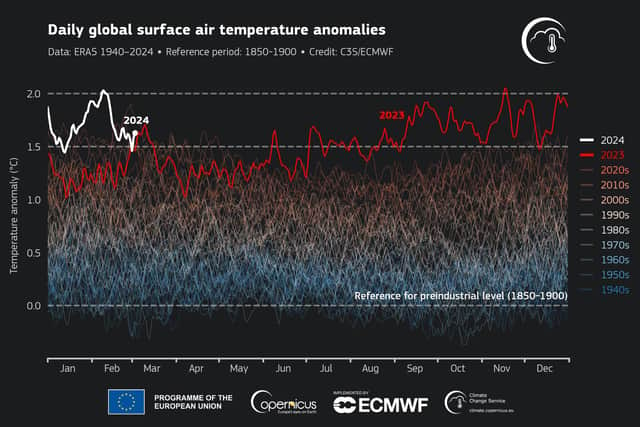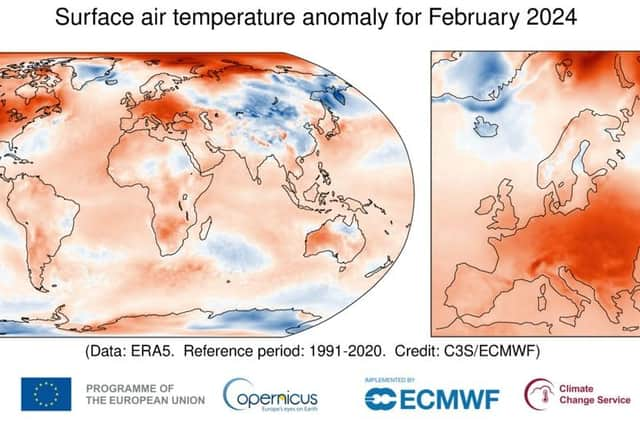Climate change: High February temperatures smash global weather records as planet heats up
Last month was the world’s warmest February on record, it has been revealed.
It was also the ninth month in a row where temperatures were the hottest in modern history for the time of year. Sea surface temperatures in February 2024 were also at their highest ever known.
Advertisement
Hide AdAdvertisement
Hide AdFigures released by the EU-funded Copernicus Climate Change Service (C3S) show the global average surface air temperature in February was 13.54C.
That is 0.81C above average for the month over the past 30 years and 0.12C hotter than the previous warmest February, in 2016.
Last month was 1.77C warmer than in pre-industrial times, before humans began burning fossil fuels on a massive scale and pumping carbon dioxide into the atmosphere – way over the 1.5C target warming limit set out in the Paris Agreement.
The global average temperature for the past 12 months is the highest on record too, at 0.68C over the 1991-2020 figure and 1.56C above levels in 1850-1900. The daily global average temperature was exceptionally high during the first half of the month, reaching 2C above the 1850-1900 levels on four consecutive days.


Europe experienced the most extreme heat anomalies in February, with the average temperature 3.3C above readings in 1991-2020. Central and eastern Europe were the hottest of all.
Elsewhere, northern Siberia, central and north-west North America, the majority of South America, much of Africa and western Australia were also hotter than usual.
Oceans were also much warmer. Monitoring shows the average global sea surface temperature in February was 21.06C, the warmest for any month on record.


The previous peak of 20.98C was set in August 2023. A new absolute high of 21.09C was reached on a single day at the end of the month.
Advertisement
Hide AdAdvertisement
Hide AdThe record-breaking monthly temperature trend comes as annual global temperatures follow the same pattern, with the past ten years the warmest on earth for millennia and 2023 the hottest of all – by a significant margin.
The El Niño natural weather system, which warms oceans and affects winds, has been pushing up temperatures in recent times.


But climate change, caused by emissions of carbon dioxide and methane from human activities, has been named as the major driver of escalating temperatures. Weather experts have warned that record-breaking weather is becoming commonplace.
“February joins the long streak of records of the last few months,” said Carlo Buontempo, director of Copernicus Climate Change Service (C3S). “As remarkable as this might appear, it is not really surprising as the continuous warming of the climate system inevitably leads to new temperature extremes.
“The climate responds to the actual concentrations of greenhouse gases in the atmosphere, so unless we manage to stabilise those we will inevitably face new global temperature records and their consequences.”
Last year alone saw widespread severe environmental conditions linked to climate change, including major droughts, deadly wildfires, catastrophic storms and devastating floods in many countries across the world.
And 2024 is predicted to be a strong contender for setting a new record as the planet’s hottest year, especially as the current El Niño event is expected to exert an even stronger influence on the world’s weather over the next few months.
Comments
Want to join the conversation? Please or to comment on this article.